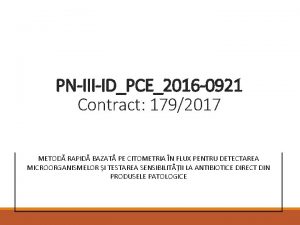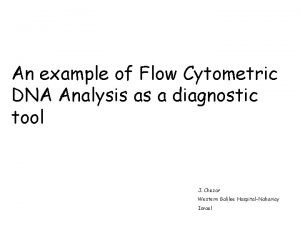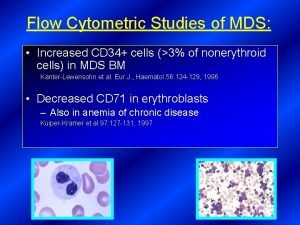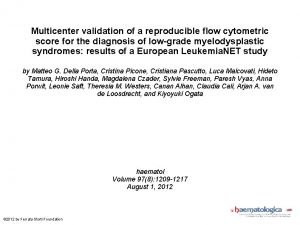PNIIIIDPCE2016 0921 Contract 1792017 RAPID FLOW CYTOMETRIC METHOD





- Slides: 5

PN-III-ID_PCE_2016 -0921 Contract: 179/2017 RAPID FLOW CYTOMETRIC METHOD FOR MICROBIAL DETECTION AND ANTIBIOTIC SUSCEPTIBILITY ASSAY DIRECTLY FROM CLINICAL SPECIMENS

PARTICIPANTS Research Institute of University of Bucharest Project leader: Prof. dr. Carmen Chifiriuc • Research team, expertise domains: - Luminita Marutescu – researcher (ICUB), microbiology, flow cytometry - Crina Kamerzan – researcher (ICUB), analytic chemistry, flow cytometry - Violeta Cristea –researcher - Microbiology Department, Synevo, microbiology, epidemiology - Marcela Popa- researcher (ICUB), clinical microbiology, antibiotic resistance - Ilda Barbu – researcher (ICUB), molecular epidemiology, antibiotic resistance - Irina Gheorghe - researcher (ICUB), molecular epidemiology, antibiotic resistance

WORKING PACKAGES • Collection of bacterial strains with relevant resistance phenotypes • Epidemiological Identification of genetic support study for antibiotic resistance Flow cytometric analysis of antibiotic resistance phenotypes • Detection of morphological and functional changes induced by antibiotics in bacterial isolates with antibiotic resistance phenotypes previously assessed • Statistical analysis • Validation of susceptibilty testing FC protocol on different artificial matrices Developement of flow cytometry susceptibilty testing protocol Validation of flow cytometry susceptibilty testing protocol directly in clinical specimens • Sensitivity • Specificity • Acuracy

Objective The aim of this project is to enhance the potential of flow cytometry to create a cost-effective, accurate, rapid and easy-to-use test for resistance bacterial infections directly from the clinical specimens that will allow health professionals to orient the emergency antibiotic therapy, in order to tackle the growing levels of antimicrobial resistance. The specific objectives are: - Investigation of the morphological and functional changes induced by antibiotics in bacterial strains with previously characterized resistant phenotypes (dye exclusion technique – with double staining protocol); - Development of a rapid FCM – based protocol able to differentiate among susceptible and resistant bacterial strains to large spectrum antibiotics used in the empiric therapy; iii) - Validation of the susceptibility testing FCM protocol using different artificial spiked matrices, i. e. urine, blood and cerebrospinal fluid (CSF), as well as clinical specimens: a) background fluorescence and dye cross-signal assessment as specificity measurement; b) establishing the validated parameters and acceptance limits (accuracy, linearity, range); c) comparative studies of susceptibility testing on clinical specimens directly from clinical specimens (urine, blood, and cerebrospinal fluid (CSF)), by using FCM against Bauer-Kirby agar disk diffusion, E-Test, automated systems and molecular assays;

Expected results The development of a rapid flow cytometric detection method of bacteria resistant to a broad spectrum of antibiotics used in emergency empirical therapy, directly in clinical specimens, while waiting for the susceptibility standard test results, will help improve empirical (emergency) antibiotic terapy of infections in hospital settings, as well as in the prevention of antibiotic resistance. Infections produced by resistant bacteria can be quickly isolated, thus preventing the spread of resistant organisms in hospital settings as well as in other institutions.









